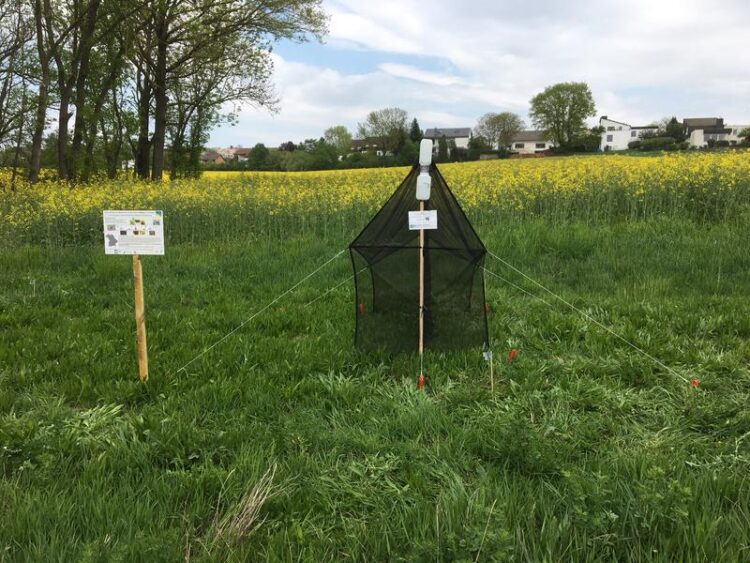Insects in the Light of Land Use and Climate

Malaise traps are highly suitable for collecting a variety of insect species in different habitats.
(c) LandKlif-Team
Urbanisation appears to be another key factor for insect decline. This is shown by a study in which the impact of climate and land use on insects was disentangled for the first time.
Worldwide, the quantity and diversity of insects are declining: scientists have reported more and more evidence for this in recent years. In politics and society, these findings have raised great concern.
Researchers attribute the decline in insect numbers on the one hand to changes in land use, for example to the increase in large monocultures such as maize and rape, but also cite climate change with increased temperatures and drought as a cause.
Previous data have weaknesses
However, these findings seem to have weaknesses, says animal ecologist Professor Jörg Müller from the Biocentre of Julius-Maximilians-Universität Würzburg (JMU) in Bavaria, Germany. Among other things, the underlying studies so far do not represent the diversity of insect species well enough or only consider short periods of time and small areas.
A research team of the Bavarian LandKlif network, coordinated by JMU, now wanted to remedy this shortcoming. The results of the study have been published in the journal Nature Communications. They show that urbanisation is another key factor for the overall decline of insects.
Study at 179 sites from low to high elevations
From Lower Franconia to Upper Bavaria, the researchers placed traps to collect flying, crawling and jumping insects in spring 2019. These Malaise-traps were located at 179 sites, from the lowlands to elevations above 1100 meters in the Bavarian Forest and the Alps. They were located in forests, on meadows and fields as well as in settlements, embedded in semi-natural, agricultural and urban landscapes.
The researchers emptied the traps every 14 days for an entire vegetation period. They determined the biomass of the insects caught and identified the individual species using DNA sequencing.
Insects benefit from higher temperatures
“In this study, we were able for the first time to disentangle the impact of climate and land use on insects in a Central European landscape,” explains Jörg Müller. “Interestingly, temperature at the local site as well as annual temperature have only positive effects on the biomass and diversity of insect populations. The form of land use, on the other hand, has different effects on biomass and diversity.”
“We observed the largest difference in insect biomass between semi-natural and urban environments. In the city, the biomass was 42 percent lower. Insect diversity was 29 percent lower in agricultural environments compared to semi-natural habitats. There were even 56 percent fewer endangered species in agricultural areas,” says Johannes Uhler, JMU PhD student and first author of the study.
Consequences for insect conservation
“These contrasting patterns of biomass and species diversity are an important warning sign for researchers,” summarizes Uhler: For insect monitoring, one should not conclude that a decline in biomass also means a decline in species diversity, and vice versa.
Based on its new findings, the JMU researchers recommend creating more green spaces in urban environments to increase insect biomass. Existing agri-environmental schemes should be further expanded to improve biodiversity and forest habitats should be promoted.
The LandKlif research network
Established in 2018, the Bavarian LandKlif research network is active in semi-natural, agricultural and urban landscapes in five climate zones in Bavaria – from the dry-warm regions in Lower Franconia to the high altitudes of the Bavarian Forest and Berchtesgaden National Parks. Its aim is to identify options for mitigating climate change and adapting to changing climatic conditions. The network coordinator is Professor Ingolf Steffan-Dewenter from the JMU Biocentre. The Free State of Bavaria is funding the network with 2.6 million euros.
Wissenschaftliche Ansprechpartner:
Johannes Uhler, University of Würzburg, Chair of Animal Ecology and Tropical Biology, T +49 931 31-89398; johannes.uhler@uni-wuerzburg.de
Prof. Dr. Jörg Müller, University of Würzburg, Chair of Animal Ecology and Tropical Biology, T +49 160 90966475, joerg.mueller@uni-wuerzburg.de
Originalpublikation:
Uhler et al (2021): Relationship of insect biomass and richness with land use along a climate gradient. Nature Communications, Open Access, 12 October 2021, doi.org/10.1038/s41467-021-26181-3
Weitere Informationen:
https://www.bayklif.de/en/verbundprojekte-landklif-en/ Website LandKlif
Media Contact
All latest news from the category: Life Sciences and Chemistry
Articles and reports from the Life Sciences and chemistry area deal with applied and basic research into modern biology, chemistry and human medicine.
Valuable information can be found on a range of life sciences fields including bacteriology, biochemistry, bionics, bioinformatics, biophysics, biotechnology, genetics, geobotany, human biology, marine biology, microbiology, molecular biology, cellular biology, zoology, bioinorganic chemistry, microchemistry and environmental chemistry.
Newest articles

NASA: Mystery of life’s handedness deepens
The mystery of why life uses molecules with specific orientations has deepened with a NASA-funded discovery that RNA — a key molecule thought to have potentially held the instructions for…

What are the effects of historic lithium mining on water quality?
Study reveals low levels of common contaminants but high levels of other elements in waters associated with an abandoned lithium mine. Lithium ore and mining waste from a historic lithium…

Quantum-inspired design boosts efficiency of heat-to-electricity conversion
Rice engineers take unconventional route to improving thermophotovoltaic systems. Researchers at Rice University have found a new way to improve a key element of thermophotovoltaic (TPV) systems, which convert heat…



